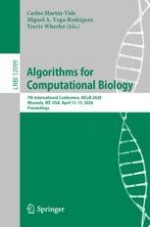2020 | Book
Algorithms for Computational Biology
7th International Conference, AlCoB 2020, Missoula, MT, USA, April 13–15, 2020, Proceedings
Editors: Carlos Martín-Vide, Miguel A. Vega-Rodríguez, Travis Wheeler
Publisher: Springer International Publishing
Book Series : Lecture Notes in Computer Science
